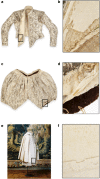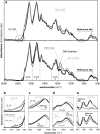Analytical markers for silk degradation: comparing historic silk and silk artificially aged in different environments
- PMID: 25492090
- PMCID: PMC4318988
- DOI: 10.1007/s00216-014-8361-z
Analytical markers for silk degradation: comparing historic silk and silk artificially aged in different environments
Abstract
Suitable analytical markers to assess the degree of degradation of historic silk textiles at molecular and macroscopic levels have been identified and compared with silk textiles aged artificially in different environments, namely (i) ultraviolet (UV) exposure, (ii) thermo-oxidation, (iii) controlled humidity and (iv) pH. The changes at the molecular level in the amino acid composition, the formation of oxidative moieties, crystallinity and molecular weight correlate well with the changes in the macroscopic properties such as brightness, pH and mechanical properties. These analytical markers are useful to understand the degradation mechanisms that silk textiles undergo under different degradation environments, involving oxidation processes, hydrolysis, chain scission and physical arrangements. Thermo-oxidation at high temperatures proves to be the accelerated ageing procedure producing silk samples that most resembled the degree of degradation of early seventeenth-century silk. These analytical markers will be valuable to support the textile conservation tasks currently being performed in museums to preserve our heritage.
Figures







References
-
- Tímar-Balázsy A, Eastop D. Chemical principles of textile conservation. Oxford: Butterworth-Heinemann; 1998.
-
- Shimura K, Kikuchi A, Ohtomo K, Katagata Y, Hyodo A. Studies on silk fibroin of Bombyx mori. Fractionation of fibroin prepared from the posterior silk gland. J Biochem. 1976;80:693–702. - PubMed
-
- Takahashi Y, Gehoh M, Yuzuriha K. Crystal structure of silk of Bombyx mori. J Polym Sci B Polym Phys. 1991;29:889–891. doi: 10.1002/polb.1991.090290714. - DOI
Publication types
MeSH terms
Substances
LinkOut - more resources
Full Text Sources
Other Literature Sources

